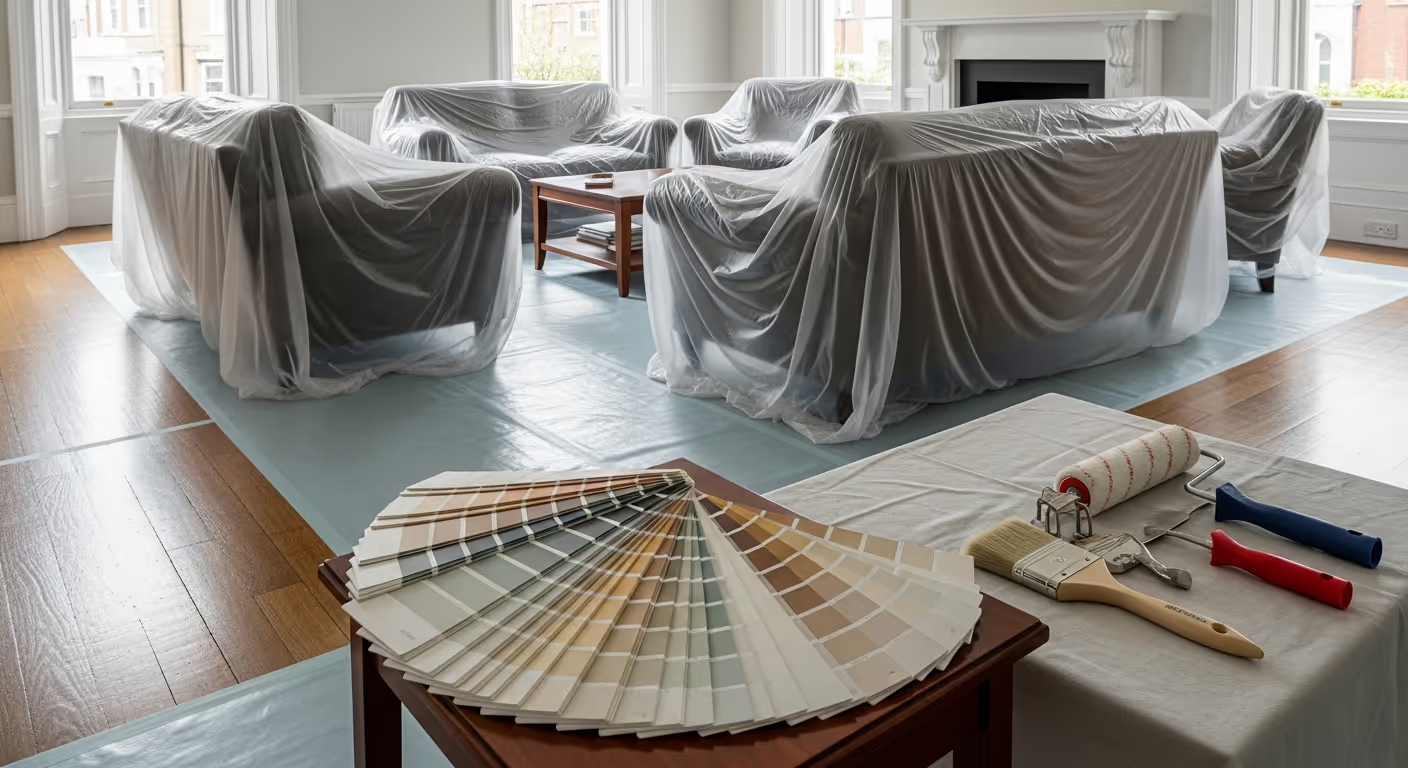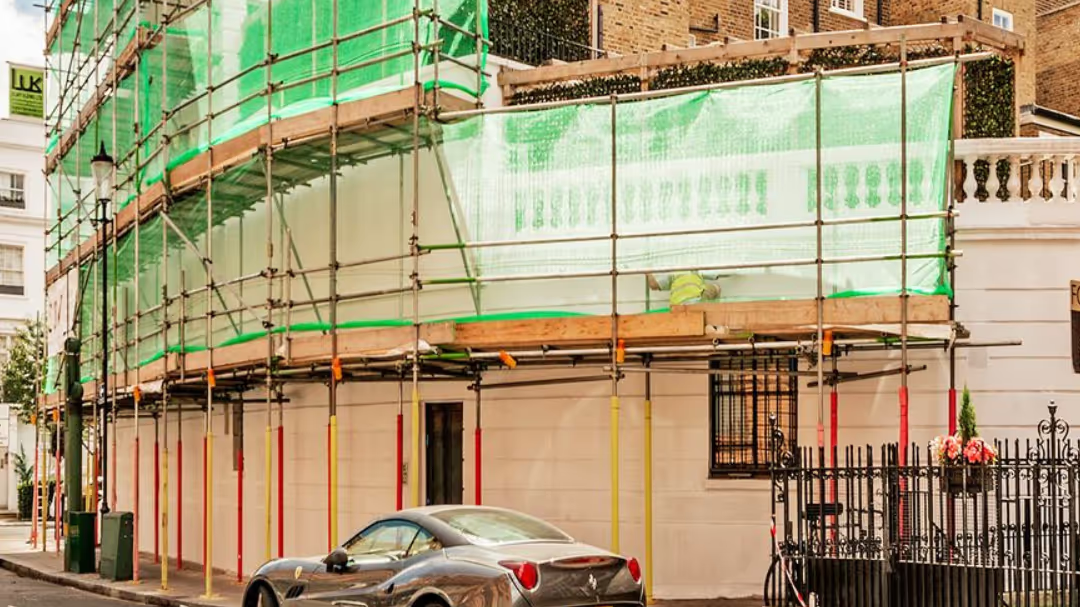
Grasscloth brings warmth and texture, but it can show every bump if the base is not perfect. This guide explains the lining method that stops telegraphing, how to plan seams, and the steps that keep your walls looking calm and even.

Short answer: A flawless grasscloth install starts with a smooth, stable base. We skim or fill where needed, line the walls correctly, set true plumb lines, and place seams where light is kind. This stops telegraphing and gives the soft, natural look people want from grasscloth. If you are planning a project now, see our wallpaper installation service for the full process.
Grasscloth is beautiful because it is natural. Fibres catch the light and add quiet texture that paint cannot match. That same texture makes it honest. Any bump or ridge under the surface can show as a line. The key to success is patient prep and a lining system that creates an even, balanced base. In prime London homes, where light falls across long walls and built in joinery, the difference between a rushed base and a careful one is clear at a glance. This guide sets out how to stop telegraphing, how to plan seams so they sit in kind light, and how to care for the finished room.
Telegraphing is the visible print through of what sits under the wallcovering. Old paint edges, joint ridges, skim ripples, or debris leave a faint line that shows when light hits at an angle. Grasscloth magnifies this because the face is not printed paper but a woven or laid fibre. A small ridge becomes a visible line. The fix is a smooth, uniform base with lining that spreads tiny movements across the whole wall so no single line stands out.
Before any prep, we read the room. Where does light enter. Where do you stand and look. Which walls have long side light from windows or lamps. We mark the main sight lines and note any strong raking light. This tells us where a seam will hide in shadow and where even a perfect seam should be avoided. It also tells us which walls need extra care with skim and lining. Calm results come from this first read, not from chasing issues later.
The base must be clean, sound, and smooth. We remove loose paint and feather back any edges. Small dings and dents are filled and sanded. If a wall has old lining with ridges or poor joints, we strip it. Where plaster is uneven, a light skim brings everything into one plane. Kitchens and bathrooms need a dry, stable base. High humidity rooms can move, so the base must be fully cured and primed. When the wall feels like a single smooth sheet under the palm of your hand, it is ready to line.
We use the primer or size that matches the backing on your grasscloth. Many grasscloths prefer a clear, acrylic size on the base to control suction and allow clean slide during hanging. On porous plaster we seal first, then size. The goal is a base that lets us place a drop with care and apply even pressure without dragging fibres. Adhesives are gentle and chosen to suit natural materials. Harsh paste can stain the backing, so we keep the system simple and tested.
Lining gives the wall a uniform face. It reduces suction changes, spreads tiny movements, and hides small ripples that might telegraph under a natural fibre. We choose lining weight to match the wallcovering. Heavier grasscloths often pair with a medium or heavy grade lining. We hang lining vertically for most grasscloths so seams do not sit over the same line as the top material. In rooms with tricky movement, cross lining can help, but we always follow the maker’s advice. Joints in lining are butted, not overlapped, then sanded lightly if needed for a seamless base.
A true plumb line sets the whole installation. We strike a line from ceiling to skirting where sight lines are kind. Near a window or in the centre of a long wall works well. Starting on a random corner invites drift as you move across the room. The first drop sets the rhythm for the pattern and the seam layout. We check the line under both natural and artificial light. Small drift that you cannot see at arm’s length can show at night when lamps rake across the surface, so care here pays off later.
Grasscloth has shade variations. They are part of the charm. We shuffle rolls and mix drops from different rolls to balance tone around the room. We place seams where light is soft and away from exposed outside corners. On stairwells and landings, we avoid first sight lines where a seam would be the very first thing you notice. In bedrooms, we keep the headboard wall as clean as possible. Where an outside corner cannot be avoided, a sharp double cut can keep the line tight without creating a raised edge.
Natural fibres need a gentle hand. We cut on a clean bench with fresh blades. We avoid pressing tools hard into the surface. When smoothing, we use soft rollers or brushes made for fabric wallcoverings. Hard plastic tools can bruise the fibres and leave a shine that never blends out. Paste is kept off the face. If any paste touches the surface, we remove it at once with a barely damp cloth and then pat dry with a clean towel. Many makers say dry dust only after curing, so we keep the face spotless during the hang.
Sockets and switches are common points of failure when people rush. We loosen plates where safe, cut cleanly, and refit for a neat edge. Window reveals often need short returns. We cut slightly long, ease the material into the reveal, and trim with light passes. The aim is a relaxed fit. For alcoves and shelves, we template complex shapes so the fibres sit without strain. The less stress we put on the material during fitting, the better it looks over time.
Stable rooms give stable results. We keep the room gently warm, not hot, and we avoid high humidity. Doors and windows are closed during pasting and early curing so the adhesive sets at a steady rate. Sudden drafts or heaters can shrink or stretch material before it bonds, which invites seams to open. If the room has underfloor heating, we turn it to a low, even setting during the work and early curing. Calm conditions equal clean seams.
Time depends on room size, number of cuts, and how much base work is needed. A calm bedroom might be a one to two day job for two installers, including lining and a careful hang. Large reception rooms with many reveals or bookcases can take longer. Rushing a grasscloth hang makes flaws that you cannot hide later. We prefer a steady pace with checks under different lights before we call a wall finished.
Let the room settle. Keep hands off seams during the first days. Dust with a soft cloth. Avoid wet cleaning unless the maker says it is safe. Natural fibres can stain if water sits on them. Where a room gets daily use, set hooks and handles so bags and coats do not rub edges. If a mark appears, try a clean, soft brush first. For delicate silk blend cloths, call before you attempt any cleaning. A quick visit often saves a visible patch.
Grasscloth looks strongest when the rest of the room supports it. Calm painted ceilings and trim in a matched tone let the texture speak without noise. If you plan painted joinery or a resprayed kitchen in a nearby room, keep tones in the same family. You can see how this balance works in our West London period home project and our Georgian London interior case study.
Not all grasscloths behave the same. Some are fine and even. Others have thicker fibres with stronger texture. In rooms with strong side light, finer weaves show fewer shadows across seams. In quieter, low light rooms, a bolder weave can add depth without looking busy. Order a couple of sample sheets and stick them to the lined wall for a day. Look at them in morning and evening. Pick the one that stays calm in all light.
Will seams be visible? With grasscloth, seams are part of the story. The goal is to make them even and quiet. Good lining and smart placement keep them discreet.
Can I hang grasscloth in a bathroom? Only in dry powder rooms with good airflow. For steamy rooms, choose a vinyl grasscloth lookalike and use real grasscloth in dry areas.
Can we repair a damaged panel? Small stains and snags are hard to hide. We keep spare material from your batch for future repairs. A neat replacement panel looks better than a patch.
Do I need lining if my walls look smooth? Yes for best results. Lining evens suction and movement and stops small flaws from printing through over time.
.avif)
We install grasscloth across Prime Central London, with frequent projects in Kensington, Chelsea, Belgravia, Notting Hill, Knightsbridge, and Westminster. If you want a calm, even result with no telegraphing, we can visit, test the base, and set a clear plan. You can request a site visit or view more of our recent projects before we meet.
Ready to plan your grasscloth room? Share room photos, wall sizes, and the brand and roll details. We will reply with a lining plan, a seam layout, and a steady schedule. For other finishes in the same project, explore our interior painting and decorating page to keep the whole home in one calm style.



You can also complete the form to send us a message, or call us on (0203) 5810807